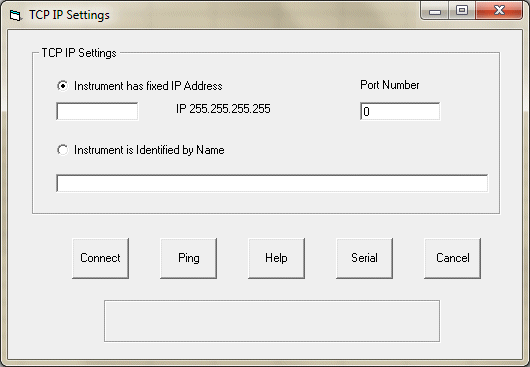Monitor - ISSN 1472-0221
The Newsletter for Data Acquisition and Control
Issue 259 May 2020
Good afternoon and thanks for subscribing. We hope this email finds you safe and well.
You can download a pdf copy of this newsletter here.
Contents
* Understanding TCP/IP for data acquisition
* Your DAQ Questions Answered
* Data Acquisition News Round-Up
Understanding TCP/IP for data acquisition
Web link: https://www.windmill.co.uk/tcpip-data-logger.html
IP Address | Static or fixed IP Address | Dynamic IP Address | Port Number | Subnets | Gateways | Name Servers | Ping Utility
TCP/IP is a standard method for sending messages across a network. It is used on many networks including the Internet. You do not need to be a network expert to use it but some key facts will make it more understandable.
IP Address
Each computer on the network has an IP Address. This is actually a 32 bit binary number. Since such numbers are not user friendly they are usually presented in Dotted Decimal Notation. This splits the 32 bits into four 8-bit chunks. Each chunk is then converted to a decimal number in the range 0 to 255. For example 01011001 00011101 11001100 00011000 becomes 89.29.204.24
You can think of this address as being roughly like a postal address arranged as Country / City / Street / House Number.
Static or Fixed IP Addresses
An instrument may have a fixed IP Address which is allocated to it by a Network Administrator. The allocated address will be unique for the network. Your instrument will have a utility supplied by the manufacturer which will allow you to set the address.

Configuring the free Windmill ComDebug software to log from a TCP/IP device
Dynamic IP Addressees
Alternatively an instrument may be allocated its IP Address when it powers up. This uses a process called Dynamic Host Configuration Protocol (DHCP). In this system the unit is identified by a name eg "My Instrument". When it powers up it asks a DHCP server to allocate an IP Address to "My Instrument". As the user, you need only decide to address the instrument by its IP Address or by its Name: the rest is done for you by the operating system.
Port Number
TCP/IP messages are sent not just to an IP Address but also to a Port Number within that address. This allows the message to be directed to one of potentially many applications running on the computer or instrument. Some port numbers are allocated to functions which all devices will support whilst others are for more general use. Your Instrument documentation will tell you which port to contact.
Subnets
Large networks are physically divided into subnets. Two devices which are on the same subnet can send messages directly to each other without the messages being seen by the rest of the network. This reduces traffic in the wider network.
The subnet is defined by the Subnet Mask. You can view this via Control Panel and the TCP/IP properties of your computer. This is another dotted decimal arrangement. For 2 units to be on the same subnet the parts of their IP Addresses which are covered by a binary 1 in the Mask must be the same. So if the Mask is 255.255.255.0 then the first 3 elements of both IP Addresses must be the same to be on the same subnet. (255 is the decimal equivalent to binary 11111111.)
If a unit whose IP Address puts it onto one subnet is physically plugged into another subnet then you will not be able to talk to it as your messages will be sent to the wrong subnet.
Gateways
When your computer wishes to send a message to a device on another subnet it sends the message via a Gateway. This is another computer which relays the message to the destination address. Your computer needs to know the IP Address of the Gateway. You can view this in the TCP/IP properties of your computer.
Name Servers
When your computer wishes to send a message to a named destination then it asks a Name Server to resolve the name to an IP Address. Your computer needs to know the IP Address of the Name Server. You can view this in the TCP/IP properties of the computer.
Ping Utility
This is a test utility which sends a message to a defined port within your instrument. The instrument replies with a short data message. Virtually every unit on TCP/IP will support this action. If you cannot Ping your instrument you will not be able to talk to it.
Read more on connecting instruments to a network using TCP-IP.
Your Data Acquisition Questions Answered: Tunnel Sensors
Question
We are looking for a Tunnel sensors to monitor the speed and direction of the vehicles. Tunnel length 6 meters. Two Cross lanes One IN and another OUT.
Answer
We recommend the Retail Sensing system. This video sensing system uses one camera to count vehicles in and out, making the data available over the internet. More details are at https://www.retailsensing.com/vehicle-traffic-counting.html
DAQ News Round-up
Welcome to our round-up of the data acquisition and control news. If you would like to receive more timely DAQ news updates then follow us on Twitter - @DataAcquisition - or grab our rss feed.
Butterflies and Peacocks inspire next generation of smart sensors
Scientists have taken inspiration from the biomimicry of butterfly wings and peacock feathers to develop an innovative opal-like material that could be the cornerstone of next generation smart sensors.
Source: University of Surrey
https://www.surrey.ac.uk/

System speeds up sampling rate of solar cells
Tests on new designs for next-generation solar cells can now be done in hours instead of days, claim scientists at Australials Monash University.
Source: The Engineer
https://www.theengineer.co.uk
Footstep Sensors Identify People by Gait
The supersensitive system can also glean clues about health
Source: Scientific American
https://www.eurekalert.org/
Safe Spacer wearable could help ensure social-distancing compliance
Safe Spacer uses ultra-wideband (UWB) technology to sense precise measurements down to approximately 10cm, which is ten times more accurate than Bluetooth applications. UWB also maintains its accuracy when multiple devices are in close proximity, something Bluetooth can struggle with.
Source: E&T
https://eandt.theiet.org/
Towable sensor free-falls to measure vertical slices of ocean conditions
Researchers at MIT and the Woods Hole Oceanographic Institution (WHOI) have engineered a lightweight instrument that measures both physical and biological features of the vertical ocean over small, kilometer-wide patches.
Source: SCUBA News
https://news.scubatravel.co.uk/
* Copyright Windmill Software Ltd
* Reprinting permitted with this notice included
* For more articles see https://www.windmill.co.uk/
We are happy for you to copy and distribute this
newsletter, and use extracts from it on your own web
site or other publication, providing the above notice
is included and a link back to our website is in place.
For previous issues by subject see https://www.windmill.co.uk/monitorindex.html
SUBSCRIBING OR CANCELLING SUBSCRIPTION Visit https://www.windmill.co.uk/newsletter.html and add or remove your e-mail address.
Windmill Software Ltd, PO Box 58, North District Office,
Manchester, M8 8QR, UK
Telephone: +44 (0)161 834 6688
Facsimile: +44 (0)161 833 2190
E-mail: monitor@windmillsoft.com
https://www.windmill.co.uk/
https://www.windmillsoft.com/
